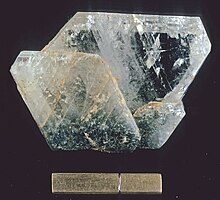| Albites | |
|---|---|

| |
| General | |
| Category | plagioclase, feldspar, tectosilicate |
| Formula (repeating unit) | NaAlSi 3O 8 or Na 1.0–0.9Ca 0.0–0.1Al 1.0–1.1Si 3.0–2.9O 8 |
| IMA symbol | Ab[1] |
| Strunz classification | 9.FA.35 |
| Crystal system | Triclinic |
| Crystal class |
|
| Space group | C1 |
| Unit cell |
|
| Identification | |
| Color | White to gray, blueish, greenish, reddish; may be chatoyant |
| Crystal habit | Crystals commonly tabular, divergent aggregates, granular, cleavable massive |
| Twinning | Common giving polysynthetic striae on {001} or {010} also contact, simple and multiple |
| Cleavage | Perfect on {001}, very good on {010}, imperfect on {110} |
| Fracture | Uneven to conchoidal |
| Tenacity | Brittle |
| Mohs scale hardness | 6–6.5 |
| Luster | Vitreous, typically pearly on cleavages |
| Streak | White |
| Diaphaneity | Transparent to translucent |
| Specific gravity | 2.60–2.65 |
| Optical properties | Biaxial (+) |
| Refractive index |
|
| Birefringence | δ = 0.010 |
| 2V angle | 85–90° (low); 52–54° (high) |
| Dispersion | r < v weak |
| Melting point | 1,100–1,120 °C (2,010–2,050 °F) |
| Other characteristics | Low- and high-temperature structural modifications are recognized |
| References | [2][3][4] |
Albite is a plagioclase feldspar mineral. It is the sodium endmember of the plagioclase solid solution series. It represents a plagioclase with less than 10% anorthite content. The pure albite endmember has the formula NaAlSi
3O
8. It is a tectosilicate. Its color is usually pure white, hence its name from Latin, albus.[5] It is a common constituent in felsic rocks.
- ^ Warr, L.N. (2021). "IMA–CNMNC approved mineral symbols". Mineralogical Magazine. 85 (3): 291–320. Bibcode:2021MinM...85..291W. doi:10.1180/mgm.2021.43. S2CID 235729616.
- ^ Handbook of Mineralogy
- ^ Mindat.org
- ^ Webmineral data
- ^ One or more of the preceding sentences incorporates text from a publication now in the public domain: Chisholm, Hugh, ed. (1911). "Albite". Encyclopædia Britannica (11th ed.). Cambridge University Press.